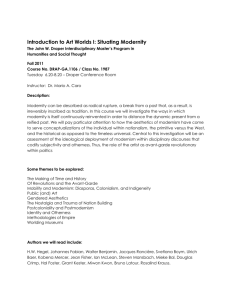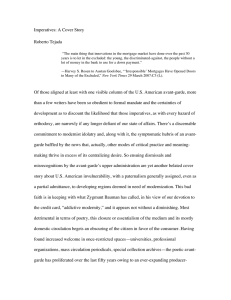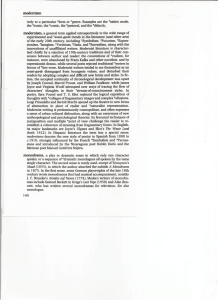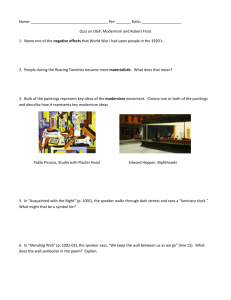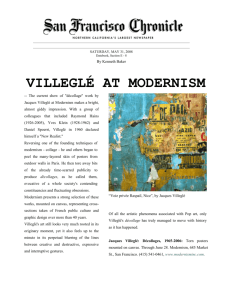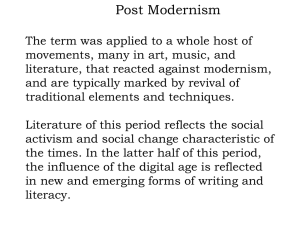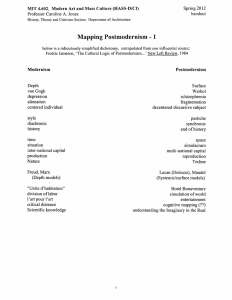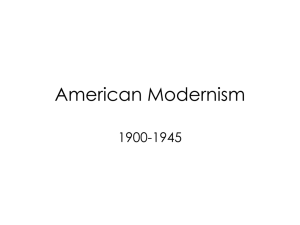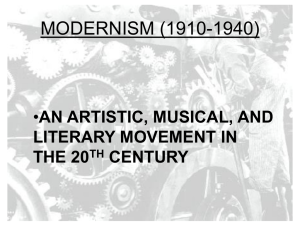Barrett 1 Mike Barrett *.031 21
advertisement
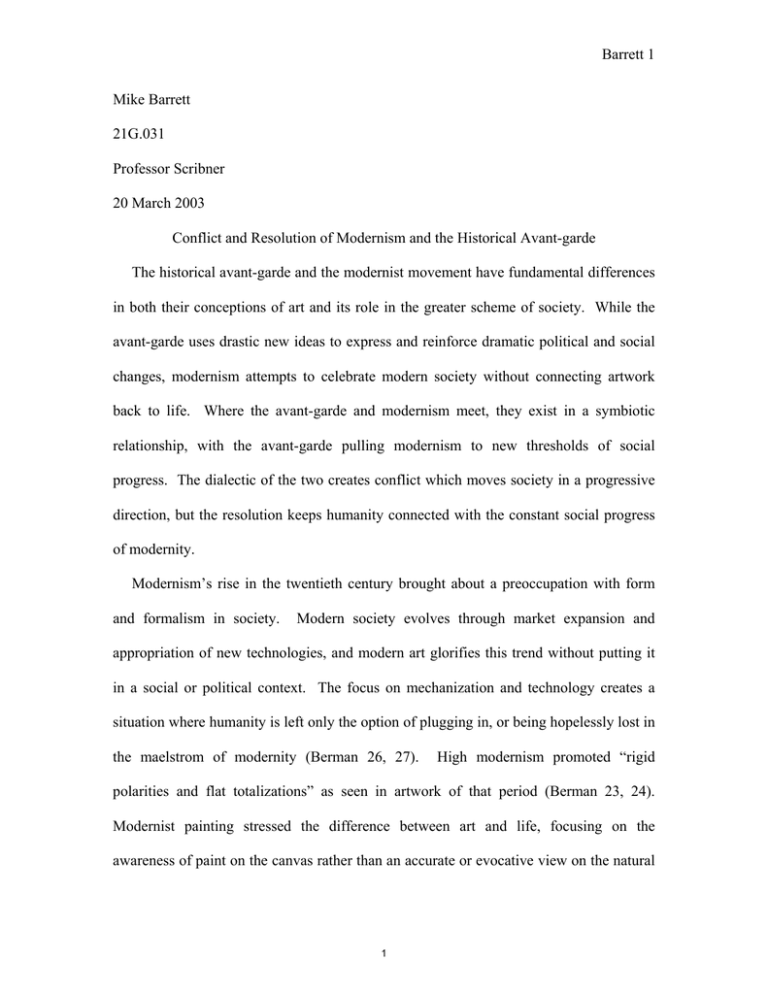
Barrett 1 Mike Barrett 21*.031 Professor Scribner 20 March 2003 Conflict and Resolution of Modernism and the Historical Avant-garde The historical avant-garde and the modernist movement have fundamental differences in both their conceptions of art and its role in the greater scheme of society. While the avant-garde uses drastic new ideas to express and reinforce dramatic political and social changes, modernism attempts to celebrate modern society without connecting artwork back to life. Where the avant-garde and modernism meet, they exist in a symbiotic relationship, with the avant-garde pulling modernism to new thresholds of social progress. The dialectic of the two creates conflict which moves society in a progressive direction, but the resolution keeps humanity connected with the constant social progress of modernity. Modernism’s rise in the twentieth century brought about a preoccupation with form and formalism in society. Modern society evolves through market expansion and appropriation of new technologies, and modern art glorifies this trend without putting it in a social or political context. The focus on mechanization and technology creates a situation where humanity is left only the option of plugging in, or being hopelessly lost in the maelstrom of modernity (Berman 26, 27). High modernism promoted “rigid polarities and flat totalizations” as seen in artwork of that period (Berman 23, 24). Modernist painting stressed the difference between art and life, focusing on the awareness of paint on the canvas rather than an accurate or evocative view on the natural 1 Barrett 2 world. Trends in modernism are towards mechanization and the “machine aesthetic,” and away from concerns of social life (Berman 26). As society changes and progresses, modern man must reinvent himself in order to stay compatible with the current state of modern existence. However, humanity, art, and life are intrinsically linked; socially aware art allows a natural evolution of man along with social progress. The avant-garde reaction to high modernism was often violent and novel, as in the rise of agit-prop artwork in communist Russia. The works of Soviet artists were politically and culturally aware, seeking to extol and further the triumphs of socialism. The avant-garde sought to bring art and humanity back into contact with each other, recognizing the effects and benefits of socially aware art. Sergei Eisenstein’s cinema, for example, used new editing techniques and compositional ideas to achieve a sociopolitical end. He felt that art was the intersection of industry and nature, and that meaning is found in the space between (Eisenstein 105). Eisenstein’s montage technique, which brought him to the forefront of Russian cinema, juxtaposes contrasting and conflicting images in order to elicit an emotional reaction in his art. By using elements of cinematographic style such as framing, movement within the frame, symbolism, and emotional content Eisenstein places images into sequences which become more than just a static progression of images. In The Battleship Potemkin, the repeated use of the kino-fist throughout the piece calls both the characters on the screen, as well as the audience, to political action and revolution. By putting three different statues of a lion (lying down, half-risen, and standing up roaring) in succession, he creates the illusion that the lion is rising up, similar to the workers in Odessa rising against their Tsarist masters. The montage style and editing of his films impart an 2 Barrett 3 emotional reaction to his viewers, which is then translated into a celebration of the triumphs of workers and modern Communism. The combinations of images within his films create conflicts through colliding imagery, but the opposing ideas become inextricably linked. While high modernism moves away from depictions of life and political themes, the avant-garde reconnects society with the very things modernism avoids. Despite the conflict between the two, modernism converges with the avant-garde for brief moments, which brings about positive social change. Modernity, in its push for globalization and standardization, moves towards absolutes. However, this creates a “broken connection between our culture and our lives” (Berman 42). In the attempt to reconcile life with the directions modern society moves in, the avant-garde creates novel art as a reaction against this incompatibility. Always seeking to move toward the newest and most modern plateau, modernism then appropriates the new ideas, and adapts them to its own ends. However, as soon as the industry discovers the new art form, it is appropriated and becomes part of modern society (Adorno 132). The resolution that arises from the dialectic of modernism and the avant-garde is what keeps modernist society from spiraling out of control. Modernity is a “unity of disunity” which creates a whirlwind of conflict and upheaval (Berman, 15). In the drive to keep completely modern, social trends have a tendency to move away from humanity and towards technological ends, downplaying an important role of social stability. The avantgarde ensures that social expansion keeps man at the forefront of culture and art by remaining connected to social and political ideas. Adorno and Horkheimer argue that the “individual is an illusion,” but individuality is what keeps society from collapsing 3 Barrett 4 (Adorno, 154). As modernism adapts avant-garde ideas under the guise of modern progress, it reintroduces humanity into the system. The avant-garde ties art back in with culture, which grounds out modernism and stabilizes society. Modernity pushes society to new levels through technological expansion. The avantgarde incorporates these changes into art that explores the conflicts of technology and life. For example, Eisenstein’s cinema uses montage to engage the viewer with social and political ideas that are linked with the emotional content of his artwork. Modernity then takes avant-garde ideas and reincorporates them into modern society. The dialectic of modernism and the historical avant-garde allows for forward social progress brought about by modernity, but keeps this consistent with a natural human evolution. 4 Barrett 5 Works Cited Berman, Marshall. All That is Solid Melts into Air : The Experience of Modernity. New York: Simon and Schuster, 1982. Cohen, M and Mast, G. eds. Film Theory and Criticism. New York: Oxford UP, 1985. Horkheimer, Max and Adorno, Theodor W. Dialectic of Enlightenment. New York: Continuum, 1997. 5 MIT OpenCourseWare http://ocw.mit.edu 21G.031J / 4.608J Topics in the Avant-Garde in Literature and Cinema Spring 2003 For information about citing these materials or our Terms of Use, visit: http://ocw.mit.edu/terms.
